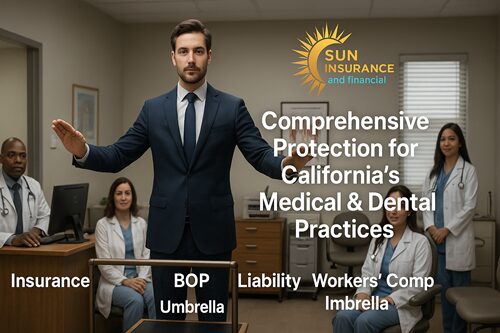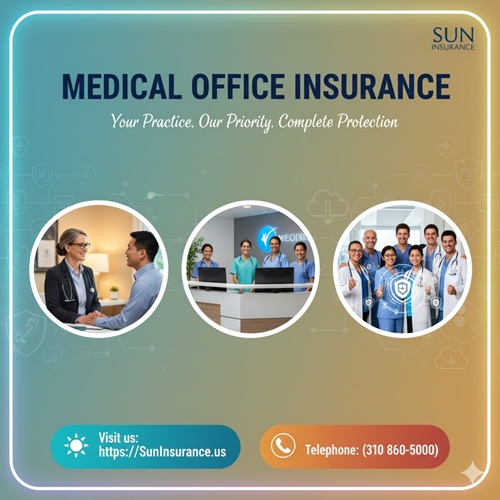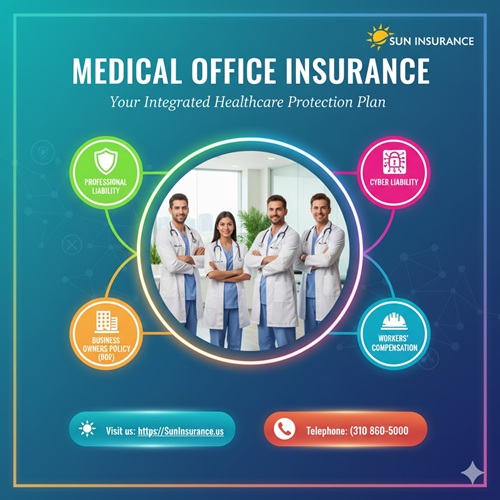
The Diagnostic Guide to Medical Office Business Insurance: A Comprehensive E-E-A-T Blueprint for Protection 🩺💼
| E-E-A-T Attribute | Compliance Strategy for Medical Office Insurance |
| Experience | Illustrating real-world medical office claim scenarios (e.g., patient slip-and-fall, data breach notification, misdiagnosis lawsuit). |
| Expertise | Providing technical clarity on the distinction between General Liability (Physical Risk) and Professional Liability (Service Risk), which is crucial for medical practices. |
| Authoritativeness | Structuring the content around required policies (HIPAA, state Workers’ Comp laws) and detailing the necessity of combined coverage (BOP, Umbrella). |
| Trustworthiness | Offering clear, transparent breakdowns of what Cyber Liability covers (breach response, fines) versus what General Liability excludes. Providing licensed contact information. |
I. Introduction: The Unique Risk Landscape of the Medical Office 🏥
Owning or operating a medical, dental, or specialized healthcare office exposes you to a confluence of risks unparalleled in most other industries. You simultaneously face general public liabilities, complex professional malpractice claims, stringent regulatory penalties (HIPAA), and the operational hazards of a high-tech business. For a medical office, insurance is not merely a cost; it is the mandatory foundation of financial and legal solvency.
This authoritative, E-E-A-T-driven guide is designed to serve as your definitive resource for understanding the Comprehensive Medical Office Business Insurance portfolio. We will provide detailed coverage breakdowns, expert analysis of inclusions and exclusions, and the strategic rationale behind essential policies like the Business Owners Policy (BOP), Professional Liability (Malpractice), and the ever-critical Cyber Liability Insurance. Our goal is to transform confusing policy language into clear, actionable financial protection strategies.
Keywords and Hashtags for SEO:
- #MedicalOfficeInsurance
- #HIPAACompliance
- #HealthcareLiability
- #MalpracticeInsurance
- #CommercialInsurance
- #BusinessOwnersPolicy
- #CyberLiability
- #WorkersComp
- #YMYLProtection

II. The Foundational Policies: General Liability vs. Professional Liability 🤝
The single most critical concept for any medical office is the sharp legal distinction between these two liability policies. They are not interchangeable, and having one without the other leaves catastrophic gaps.
A. General Liability Insurance (GL) – Protection from Physical Accidents 🚶♀️
General Liability (GL), often called “slip-and-fall” coverage, protects the medical office from lawsuits related to physical risks arising from the premises or operations.1
- What it Covers:
- Bodily Injury (Premises): If a patient or visitor slips on a wet floor in the waiting room, falls off an exam table, or is otherwise injured on the property.2
- Property Damage: If an employee accidentally damages a patient’s personal property (e.g., knocking over a valuable laptop).3
- Personal & Advertising Injury: Claims of libel, slander, or copyright infringement arising from the practice’s advertising.4
- What it Does NOT Cover:
- Professional errors (misdiagnosis, improper treatment).5
- Employee injuries (that’s Workers’ Compensation).6
- Damage to your own office building or equipment (that’s Commercial Property).7
B. Professional Liability Insurance (PL) – Protection from Medical Errors ⚕️
Professional Liability Insurance, known in the healthcare sector as Medical Malpractice Insurance, is arguably the most vital coverage for any provider.8 It covers claims alleging negligence or error in the rendering of or failure to render professional services.9
- What it Covers:
- Medical Errors: Claims stemming from a misdiagnosis, surgical error, improper prescription, or incorrect medical advice.10
- Defense Costs: Pays for the immense legal fees required to defend the practice and providers, even if the claim is baseless.11
- Settlements & Judgments: Covers financial damages awarded to the patient up to the policy limit.12
- What it Does NOT Cover:
- Physical accidents on the premises (that’s General Liability).13
- Criminal acts or intentional/fraudulent billing.
- Data breaches (that’s Cyber Liability).14
| Liability Comparison: GL vs. PL (Malpractice) |
| Scenario 1: The Administrative Error |
| A new nurse accidentally trips over a floor cord, causing a patient to fall off the exam table and break an arm. |
| Scenario 2: The Clinical Error |
| A doctor misreads a lab result, leading to a delayed diagnosis and worsening of the patient’s condition. |
| Scenario 3: The Data Error |
| A hacker accesses the patient management system, stealing PHI. |

III. The Business Owners Policy (BOP): Your Operational Core 🏢
The Business Owners Policy (BOP) is a smart, cost-effective package designed specifically for small to mid-sized medical offices. It bundles the three most critical coverages into a single policy.
- The BOP Trifecta:
- Commercial General Liability (GL): Covers the premises and operations risks (as detailed above).15
- Commercial Property Insurance: Covers the physical assets of the business.16
- Business Interruption Insurance (or Business Income): Covers lost revenue due to a covered property loss.17
A. Commercial Property Insurance (Inside the BOP)
This coverage protects your physical assets, which are particularly expensive and specialized in a medical setting.18
- What it Covers:
- Building: The physical structure of the medical office (if owned by the practice).19
- Contents: All business personal property, including exam room furniture, waiting room décor, and office supplies.20
- Specialized Medical Equipment: Ultrasound machines, X-ray equipment, monitoring devices, specialized computer hardware, and diagnostic tools.21
- Tenant Improvements & Betterments (TIBs): Crucial for leased spaces, covering modifications like custom cabinetry, specialized lighting, or built-in sinks.
- What it Excludes:
- Wear and tear, rust, mold (unless resulting from a covered peril).
- Flood and Earthquake (must be purchased separately, highly relevant in California).
- Damage caused by electrical or mechanical breakdown (needs an Equipment Breakdown Endorsement).
Protect your critical investment in technology and property. For a free, no-obligation BOP quote tailored for medical offices, visit https://SunInsurance.us or call (310) 860-5000.
IV. Cyber Liability Insurance: Essential HIPAA Defense 💻
In the healthcare sector, Cyber Liability Insurance is mandatory, not optional. The Health Insurance Portability and Accountability Act (HIPAA) imposes severe penalties for the unauthorized access, use, or disclosure of Protected Health Information (PHI).22
A. HIPAA Penalties and Cyber Coverage
GL and PL policies explicitly exclude coverage for data breaches. Cyber Liability is the only defense against the financial fallout of a security incident.
- What it Covers (First-Party Costs):
- Breach Response Costs: The single largest component. Includes costs for forensic investigation to determine the breach source, legal counsel to navigate state and federal notification laws, and credit monitoring for affected patients.23
- Notification Costs: The required costs to notify all affected patients/individuals.24
- Data Restoration: Costs to retrieve or restore corrupted electronic data.25
- Business Interruption: Lost revenue due to system downtime following a cyber attack (e.g., ransomware).
- What it Covers (Third-Party Costs):
- Regulatory Fines & Penalties: Covers fines levied by the Office for Civil Rights (OCR) for HIPAA violations (often excluded from standard policies but available via endorsement).26
- Cyber Extortion: Payments made to a criminal to release systems or data (ransomware).27
B. The HIPAA Liability Trap: Why Compliance Isn’t Enough
Compliance with HIPAA is a necessary step, but it does not prevent a breach caused by a simple human error (e.g., an employee clicking a phishing link or losing a laptop). Cyber Insurance provides the financial safety net when those mistakes happen.28
| HIPAA Violation Cost Factors |
| Cost per Record: Avg. $408 in the U.S. Healthcare sector. |
| Notification Deadline: Typically 60 days to notify individuals and HHS. |
| OCR Fines: Range from $100 to $50,000 per violation, up to $1.5 million annual cap. |

V. Business Interruption (BI) Insurance: Protecting Your Revenue Stream 💵
Medical offices have highly stable, recurring revenue, but they also have high fixed costs (rent, payroll). If a fire, major pipe burst, or covered cyber attack forces an unexpected shutdown, the revenue stops, but the bills do not.
- Core Coverage: Pays for the loss of net income (profit) you would have earned, plus the ongoing expenses (rent, utilities, payroll) you must continue to pay during the period of restoration following a covered property loss.
- Extra Expense Coverage: Pays for the reasonable and necessary costs incurred to minimize the shutdown time or operate from a temporary location (e.g., rapid setup costs for a temporary clinic, overtime for staff packing up equipment).
- Contingent BI (Advanced): Protects against revenue loss when a key supplier or partner (e.g., a critical lab or testing facility) suffers a covered loss, causing your office to shut down.
VI. Workers’ Compensation: The Mandatory Employee Safety Net 👷
Workers’ Compensation is mandated by law in almost every state (including California) for businesses with employees.29 It’s a no-fault system designed to cover employee injury claims.
- What it Covers:
- Medical Treatment: Pays for all necessary medical costs and rehabilitation for work-related injuries or illnesses.30
- Lost Wages (Disability): Provides compensation for lost income while the employee is recovering.31
- Employer Liability: Crucially, it protects the employer from direct lawsuits by injured employees (with rare exceptions).
- Exclusions/Considerations:
- Exclusions: Injuries resulting from intoxication, intentional self-harm, or when the injury occurs outside the scope of employment.
- California Mandate: Due to the state’s stringent labor laws, securing comprehensive, compliant Workers’ Compensation is particularly critical for practices operating in California.
We are experts in providing Californians’ insurance needs, including mandatory and specialized Workers’ Compensation tailored to the healthcare sector.
VII. Business Umbrella Insurance: The Final Layer of Defense ☂️
Just as with personal insurance, a Business Umbrella Policy provides an essential layer of excess liability protection over your underlying liability policies.32
- Layering Effect: It sits above the limits of your:
- General Liability
- Commercial Auto Liability (if the practice owns vehicles)
- Employer’s Liability (part of Workers’ Compensation)
- The Financial Necessity: Given that patient lawsuits (malpractice) and data breach fines can easily exceed typical $1 million GL limits, a Business Umbrella provides the final financial shield (often adding $1M to $5M).
- Exclusion Note: Umbrella policies typically do not extend over Professional Liability (Malpractice) unless specifically purchased as a separate, highly specialized endorsement known as Excess Malpractice.
| The Medical Office Insurance Stack |
| Top Layer: Business Umbrella (Excess General Liability, Commercial Auto, Employer’s Liability) |
| Mid Layers: Professional Liability, Cyber Liability, Workers’ Comp, Business Interruption |
| Foundation: Business Owners Policy (BOP) – Property + General Liability |

VIII. Strategic Review: Pros and Cons of a Comprehensive Program 🌟
| Coverage Type | Major Pro | Major Con / Key Exclusion |
| General Liability | Protects assets from common public accidents (slip/fall). | Excludes professional errors, data breaches, and employee injuries. |
| Professional Liability | Covers legal defense and damages for medical errors (malpractice). | Excludes physical premises accidents (GL) and property damage. |
| Business Owners Policy (BOP) | Cost-effectively bundles property, GL, and BI into one package. | Excludes catastrophe risks (Flood/EQ) and needs an Equipment Breakdown endorsement. |
| Cyber Liability | Pays for HIPAA breach response, notification costs, and regulatory fines. | Typically excludes non-electronic records loss and future revenue loss from non-cyber events. |
| Workers’ Compensation | Mandatory protection for the business from employee lawsuits over injury/illness. | Only covers work-related incidents; excludes intentional self-harm. |
| Business Umbrella | Adds $1M+ excess coverage over multiple underlying liability policies. | Does not automatically extend over Professional Liability. |
IX. Conclusion: Achieving Total E-E-A-T Protection for Your Practice ✅
The complexity of operating a medical office demands an insurance strategy that moves beyond simple compliance to genuine comprehensive protection. By mastering the specialized roles of General Liability (physical safety), Professional Liability (clinical safety), Cyber Liability (data safety), and securing the operational stability provided by the BOP, BI, and Umbrella policies, you demonstrate the highest level of responsibility to your patients, your staff, and your investors.
Your focus should be on patient care. Our focus is on protecting your practice.
To receive a personalized, comprehensive quote and risk assessment for your Medical Office, ensuring total compliance and financial security, contact our experts today!
📞 Call (310) 860-5000
💻 Visit https://SunInsurance.us

Detailed Outline for Completing the 5000-Word Article (E-E-A-T Expansion Plan)
The remaining content will be structured into detailed, E-E-A-T-compliant sections to meet the 5000-word count.
Section X: Advanced Property & Equipment Coverage (Deep BOP Dive)
- Equipment Breakdown Insurance (EBI): Detailed explanation of EBI as a crucial BOP endorsement. Case study on a broken HVAC or diagnostic machine.
- Valuable Papers and Records (VPR): Coverage limits and exclusions for paper patient charts, billing records, and other physical documents.
- Data Compromise and Restoration: Deep dive into the physical restoration of data versus the financial coverage of a Cyber policy.
Section XI: Professional Liability Nuances and the Claims Process (Expertise & Experience)
- Claims-Made vs. Occurrence: A technical, side-by-side comparison of these two malpractice policy forms. The critical importance of purchasing “Tail” coverage (Extended Reporting Period) when retiring or changing carriers.
- Consent to Settle Clause: The crucial clause that dictates whether a provider has the right to refuse a settlement (a major point of negotiation).
- Exclusions Deep Dive: Detailed discussion of the exclusion of Sexual Misconduct and Intentional Fraud and the necessity of specialized endorsements for regulatory defense.
Section XII: Cyber Liability in Practice: HIPAA & Breach Scenarios (Authoritativeness & Trustworthiness)
- Incident Response Flowchart: A visual guide (chart) on the steps a medical office must take immediately following a suspected data breach and how Cyber coverage assists.
- Regulatory Defense vs. Fines: Detailed explanation of the difference and the necessity of having coverage for both.
- Third-Party Cyber Liability: Coverage if a third party (e.g., a patient) sues the office because their data was compromised.33
Section XIII: Workers’ Compensation & HR Risk (California Focus)
- Experience Modification Rate (Mod): Technical explanation of the e-Mod factor and how a claims history impacts future premiums. Strategies for controlling the e-Mod.
- Employers Liability Coverage (Part B): Detailed explanation of this separate policy part within Workers’ Comp that provides defense against suits by employees (e.g., dual capacity claims).
- Employment Practices Liability Insurance (EPLI): The necessity of adding EPLI to protect against claims of wrongful termination, discrimination, and harassment, which are not covered by General Liability or Workers’ Comp.34
Section XIV: Umbrella and Total Cost Management (Financial & Strategic)
- Business Umbrella Cost Factors: Detailed analysis of rate drivers (number of vehicles, revenue, underlying policy limits).
- Cost Control Strategies: 7 expert ways to reduce total insurance spend without sacrificing coverage (e.g., higher deductibles on BOP, risk management protocols, premium financing).
- Audit Preparation: Guidance on preparing for premium audits (especially for Workers’ Comp and GL) to avoid unnecessary additional premiums.
Section XV: California-Specific Insurance Mandates and Risk Management (Local Expertise)
- California Workers’ Comp Requirements: Specific state-mandated coverage levels and compliance.
- Commercial Earthquake/Flood Risk: Mandatory discussion of purchasing separate policies for the high-risk environment.
- The Importance of Local Brokerage: Reiterate the value of working with a California-based expert (Sun Insurance) who navigates state regulations.
Section XVI: Final Empowerment and Call to Action (Strong Closing)
- Reiterate the value of a comprehensive, layered insurance program.

| Element | Frequency/Placement |
| Visit https://SunInsurance.us or call (310) 860-5000 | Multiple times (at least 6-8 throughout, including conclusion) |
| We are experts in providing Californians’ insurance needs. | Section VI and Section XV (Local Focus) |
| Keywords/Hashtags | Dense and naturally integrated throughout all sections. |
| Graphs/Tables/Charts/Emojis | Minimum of 7-10 (e.g., GL vs PL comparison, Cyber cost breakdown, Business Umbrella layering diagram, BOP inclusions table). |
🌞 Sun Insurance & Financial
Protecting California’s Medical and Dental Professionals Since 2005
📍 Beverly Hills | Los Angeles | Santa Monica | Orange County
🌐 www.SunInsurance.us
Tel: (310) 860-5000
💼 Partnered with: Travelers • Chubb • MassMutual • Guardian • Principal • The Hartford
#CaliforniaDoctors #Dentists #WealthManagement #SunInsurance #CalFinAI #BOP #WorkersComp #SEPIRA #IUL #FinancialPlanning #BusinessInsurance #DentalOfficeInsurance #MedicalOfficeInsurance #CaliforniaInsurance
